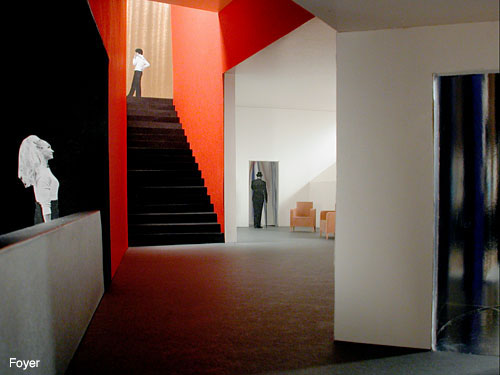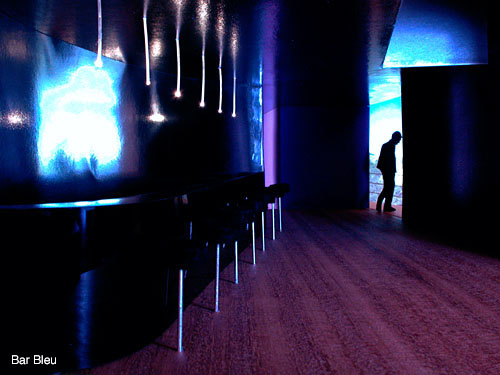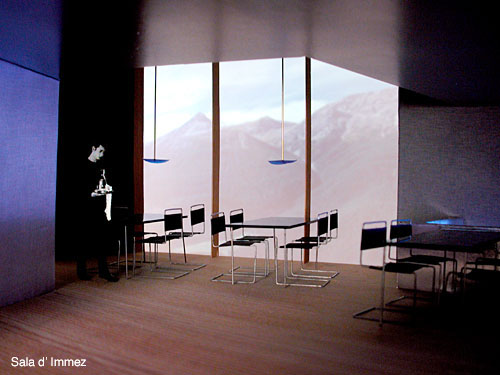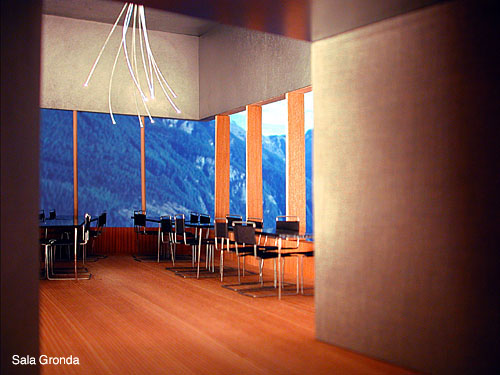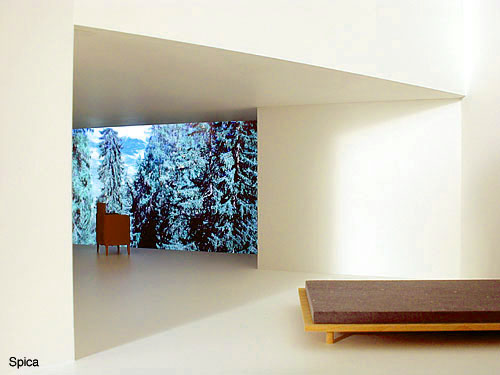Graubünden CH. 2000
(Member of Design & Presentation Team
at Architekturbüro Peter Zumthor)



But Tschlin is also a mountain community undergoing change: extensive alpine farming, empty houses and barns, fewer and fewer people able to make a living in the village. Tourism that requires holiday housing and large skilifts, tourism that swallows up and changes the old farming structures: it has not yet reached the lowest, terraced village in the valley. This was intentional and in part, perhaps, accepted with resignation. It is now the will of the community to protect their architecturally intact village while also promoting sensible developments to enhance the life and work of the people. So: a small hotel is to be built here, an establishment of a special nature. Small and distinguished. For special guests.
The guests we envision for the hotel in Tschlin come from near and far. Attracted by the unusual offer. They appreciate the quality of simplicity, the privilege of authenticity. They seek, they treat themselves to experiences of this kind. Our guests are exacting when it comes to taste and design. They appreciate large rooms, clear lines, beauty and spaciousness. Many of them are familiar with contemporary architecture and art, enjoy literature, music or films. They love beautiful objects and good materials. They approach the ancient peasant culture of a region like the Engadine with respect and joy.
The luxury, of which our guests dream, is an offer in which everything, almost everything, is right and in harmony: the place, the building, the hosts, the cuisine. No advertising fabricated out of word shells, no marketing magic. A genuine offer of things and effects that please, that are useful, that may long have been the object of desire. Cultivation, sincerity, authenticity. True luxury.
The new hotel stands at the top of the village, below a stand of larch trees. A feathered facade of long sinewy, scaled shingles of split larch wood clads the sculpted body of the building. The shaggy stump of a tree, the dark sheen of eagle feathers. Proudly it stands at the edge of the village, a feathered body of wood almost as tall as the taller of the two church spires. A compact natural object. Soon to be burnt and weathered by sun, wind and rain, it is both village-oriented and contemporary, strong and light. Room-sized panes of glass on the scaly skin of the facade hint at the adaptable, cellular disposal of the interior, derived from the special act of cell division of the entire body. The allure of the large shape, the openness and lightness of the building's upward reach impart a trace of sophistication, of urbanity, like the poised presence of the hotels set in the Alpine countryside in the latter 19th century.
The body of the hotel, erected on a ground plan no larger than a local farmhouse, is an assemblage of light membranes, sitting directly on the meadow. It grows out of the mountain slope, stands there as an object, singular and serene. The landscaping of the surroundings is minimal.
On entering the building, one enters a distinct world, joins a community for the length of one's stay, perhaps of the kind that emerged in special hotels or ocean voyages across the Atlantic. Old hospitality, redefined.
Once inside the building, all movement reaches upwards. The sweep of the road winding up the mountain continues on into the hotel. Softly rising stairs lead up to the reception area, from room to room, with changing light and view. Picture joins picture. The red stairs that climb up from the lobby, the Teatrino for special events, the Bar Bleu with its long terrace, the hotel library in the paneled hearth room, the bright succession of restaurants: Saletta, Sala d'Immez and Sala Gronda. Sequences of rooms, a variety of places inviting rest. An atmosphere that is spacious and refined. Different kinds of wood, native and foreign, create specific spatial ensembles, establish a rapport with planes of color. Dark mahogany, shining larch, silvery silk; the crackling of an open fire, port wine crystal glassware, the scent of a cigar. And everywhere this radiant light that lies on the landscape, that comes from the landscape. Magnitude and intimacy. A distinct world.
Like the structure of a particular kind of wood or a special stone seen under a microscope, the interior of the building possesses a special anatomical structure, created for its special use and special location. In various combinations, tall and low, broad and narrow, inhabitable hollow spaces permeate the building from facade to facade. The landscape penetrates the interior, flows through the rooms. Every room is an airy nest, a platform on high. Every room has a special hollow shape, a cut of its own that has evolved out of the rules governing the cellular structure of the interior. Sculptural configurations in space, one and all.
The rooms for the guests on the upper floors of the building maintain a high degree of individuality. Every room is directly accessed by elevator. There are no corridors. Guests retire and end up in the aerie that is their personal realm. The shape of the rooms from facade to facade is active. Staggered, protruding, angular. Zones with different spatial features, allowing guests to create nests of their own: looking down into the valley or up at the evening sun on the mountains.
The furnishings are simple and practical. The things one wants are there, and where they ought to be. Plenty of room; good, lightweight furniture. Table at the window, bathtub with a view and possibly linen bedclothes. One senses the hint of luxury; the feeling one has when a room welcomes people and things, makes them look beautiful, and captures the light of the landscape on a summer evening, in a November fog, in the snow of New Year's eve.
The kitchen of the mountain hotel uses fresh seasonal produce. It satisfies the most demanding palate with elegant simplicity. Local products are served: mountain goat and venison, during the hunting season of course; meat from the Paureria biologica, regional cheeses. Visitors can choose from select local dishes: tatsch and maluns, capuns and plain in pigna. The wine list is excellent. A carafe of tap water from the village spring is placed on the table at every meal. Diners notice the chef's love of simple Tuscan cuisine even when serving local specialties.
Plain tablecloths, white flatware, quiet conversations while dining in the Sala Gronda, the Sala d'Immez or the Saletta. The tables are far apart. All of them with a view. Diners meet afterwards at the Bar Bleu for a digestive, step out onto the terrace to enjoy the last rays of the setting sun before darkness falls, and the space, open to the skies, offers the delights of stargazing. Occasionally one hears Romansh, or rather the melodic local variant known as Valader, being spoken by guests or by those who see to the comfort, by the hotel manager or the restaurant staff. Only the barkeeper consistently speaks Italian.
Evenings at nine, a concert: the Franzlis da Tschlin in the Teatrino. Trumpet and violin, double bass, virtuoso clarinet, melancholy, velvety sounds and a springy rhythm. A few people dance. The music from the village speaks of the world. Sounds never heard like that before. Hotel culture.
text by Peter Zumthor ©2000
